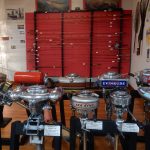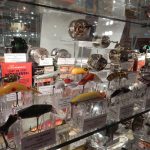The new “Gone Fishing” exhibit at the Merrill History & Culture Center puts the history of fishing equipment on display. The exhibit includes poles, rods, reels, lures and outboard motors dating back to the 1800s.
Spinning and casting reels are among the featured items, with the oldest reel on display made in 1886. Some of the manufacturers have disappeared over the years, but many of the brands are still familiar names in the industry today. Among the reels on display are those that pioneered features common on modern reels.
The featured lures date back as far as an 1874 patent date, and on up through the 1960s. They include baits from trout flies to foot-long muskie lures, and everything in between. Many of them were made locally, including Mud Puppies, made in Mosinee, to minnows made in Madison.
“There were actually a lot of baits made in Wisconsin,” said Merrill Historical Society board member Dave Johnson, “as Wisconsin was a big fishing state – still is.”
In fact, Wisconsin – along with neighboring Minnesota and Michigan – has always been a hotbed for the fishing products industry.
The display also includes a wide range of poles and rods, from short jigging poles to casting rods. The evolution of fishing poles started with bamboo, and then bamboo that had been split and glued back together.
“That gave it a lot more flexibility,” Johnson said.
With the development of the fishing reel, rods on which a reel could be mounted came into fashion. The materials switched from bamboo to steel. After World War II, fiberglass became the material of choice for fishing rods.
The display also includes an early gas-powered ice auger, made in Merrill by Otto Nienow in the early 1950s. He made and cast all of the parts himself and mated it to a Montgomery Ward motor.
“He would have been Mr. Popular out on the lake,” Johnson said. “It was an innovation then.”
Due to the weight (over 100 pounds) and power of the machine, drilling a hole with Nienow’s auger was most likely a two-man job.
“It was built with two handles for a reason,” Johnson said.
Nienow also cast his own anchors and made fishing baits.
Outboard motors on display range in date of manufacture from 1924 to 1946. Brands represented include Evinrude, ELTO, Neptune, Mercury and Water Witch. Power output of these early motors range from one-half to 3.1 horsepower. Many were manufactured in Wisconsin. Among those on display include the first model made by Mercury. These early outboard motors would have originally powered wooden boats.
The Gone Fishing display is expected to be up for about a year.
In the church basement, Gone Fishing currently shares space with an antique kitchen items display and the railroad research library.
The kitchen exhibit features everything from the first egg beater, first electric toasters, apple press, sausage stuffer, canning jars, and more from the 1860s up to the 1950s. There is also crockery dating back to 1594.
The railroad library represents the combined collections of railroad enthusiasts from Merrill and Wausau. Complete volumes of some major train magazines are featured. The research library draws train buffs from far and wide, and has also been recognized by national train magazines.
Permanent exhibits in the History & Culture Center include the Pinery, which displays Merrill history in the forest products industry from the logging boom to the sawmills and the window and door manufacturers that call Merrill home. The Pinery features a model of an early Merrill sawmill, and a multitude of tools and artifacts from the days of the “river rats.” Memorabilia from Merrill’s sawmills and window factories has also been gathered for the exhibit.
Another permanent feature is the Native American exhibit in the Ebert/Sykes Gallery on the main floor. Paul & Laura Ebert were avid collectors of logging and Native American items. When Paul passed away, the Historical Society worked with Laura and their daughter Sarah Sykes to bring this amazing collection to the Merrill History & Culture Center. There is a complete history of the evolution of Native Americans in this country and many copper, pottery and beadwork artifacts to reflect the workmanship of these early people.
The “Arnolf Tockley’s Story – Intersecting with the 20th Century” exhibit opened in September 2016 and will run through mid-April 2017. It highlights the journey that took Merrill native Tockley to the NASA Marshall Space Flight Center in Huntsville, Ala., and shows how his life intersected with many of the key themes and events of the 20th century in the U.S. The exhibit includes several model rockets on loan from NASA’s Marshall Space Flight Center in Huntsville. The exhibit was sparked by a donation of several boxes of Tockley’s belongings following his death.
The Tockley exhibit in the Merrill Room will be replaced in May with an exhibit commemorating the 100th anniversary of the Merrill Post Office building, as well as the 125th anniversary of Weinbrenner Shoe Company. Also, a World War I exhibit will be installed in the lobby.
The Merrill History & Culture Center is open for self-guided tours Monday through Friday, 9 a.m.-1 p.m., with hours extended to 3 p.m. on Wednesdays. The railroad library is available Fridays from 9 a.m.-noon or by appointment.
The Merrill Historical Society’s mission is to educate the public about our heritage using the unique historical and cultural resources we collect and preserve. For further information on the programs and activities of the Merrill Historical Society, or to become a member, please contact the Society at 715-536-5652 or [email protected], or see the website at www.merrillhistory.org.


